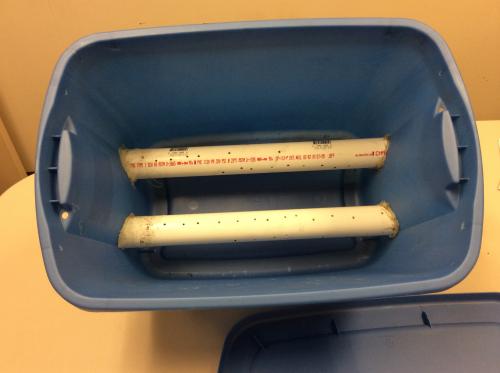Vermicomposting: A smart winter compost option
Vermicomposting is a good way to compost during winter months when your outdoor compost pile is dormant.

Many people let their compost piles go dormant during the winter months rather than continue to work the pile with little or no new yard material available. However, that does present a problem for composters who compost food waste in their pile.
Vermicomposting, a.k.a. worm composting, is a good alternative for food waste. Worm composting recycles food waste into a rich, dark soil amendment just like you get from your compost pile.
The Michigan State University Extension Master Composter Program describes vermicomposting as a simple process in which you make a bin using a plastic storage container half-filled with shredded paper (newspaper is best). The bin has one or two perforated PVC pipes running thought it to ensure sufficient oxygen. Small quantities of broken up, soft food are buried daily starting in one corner and working around to each corner and the center and then repeating.
The optimal bin is a 10-14 gallon lidded, plastic storage container. Once you’ve made the bin (you also can purchase worm bins and even worm condos!), the worms do all the work. It’s important to use the right type of worms. Regular garden worms do not work in a compost bin. The best type of worm is called Eisenia fetida or Red Wiggler. Red wigglers are available at fishing or bait stores or ordered online. If you have friends that are vermicomposting, they probably have plenty of worms and would share some with you. Eight red wigglers can produce 1500 new worms in six months if bin conditions are correct! Correct bin condition include:
- Temperature range of 55 to 77 degrees Fahrenheit.
- Moist environment – begging should be 65 to 75 percent moisture but no standing water or puddles
- Bin must remain aerobic (with oxygen)
- Neutral pH range of 7 – but worms can tolerate a range from 4.2 to 8 or higher
The worms will eat almost anything including fruit and vegetable scraps, bread and grain products, tea bags, coffee grounds and filters and non-greasy foods. Worms cannot decompose meat, bones, fat, dairy products, greasy foods or non-food items (plastic, rubber bands, aluminum foil, Styrofoam, etc).
This shows the size and spacing for air holes in the PVC pipe inside the worm bin.
Worms will eat half their weight in food every day. So the more worms you cultivate, the more food waste you can compost. Worms prefer the food to be in small pieces and soft (cooked). They are able to process it easier and faster.
If you discover the worms are dying or not thriving in your bin, some things to check are:
- Is there enough food available for the amount of worms in the bin?
- Is the bedding too dry or too wet?
- Is the bin too hot or too cold? It’s best not to store the bin in an unheated garage during winter.
- Is the bedding sufficient? Or has it been eaten and needs replacing?
- Has your worm population grown too large and needs to be divided into another bin?
There are several advantages to worm composting:
- The process requires very little work once the bin is established
- There are no odors with the process. People have been known to store their bin in the kitchen or basement
- Soil conditioner that is produced is beneficial to plants
- Vermicomposting is easy to do for apartment or condo residents and seniors or physically challenged
- This process can be done year round but is especially handy during winter months
A good reference book on worm composting is “Worms Eat My Garbage” by Mary Appelhof. If your local library does not have a copy, search “worms eat my garbage” for purchase locations.
Other sites for vermicomposting information are Cornell University’s Cornell Waste Management Institute and New York State Department of Environmental Conservation.



 Print
Print Email
Email


